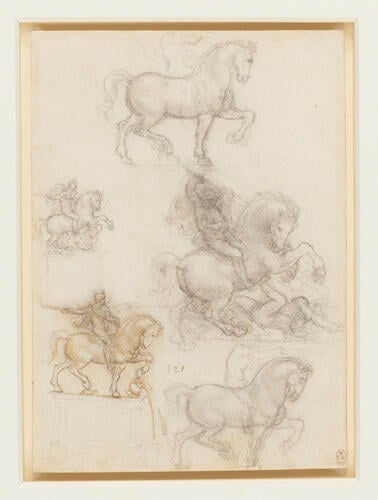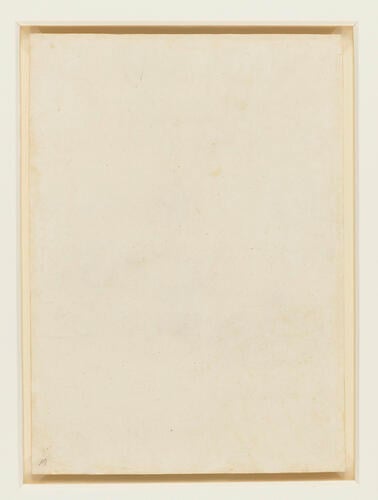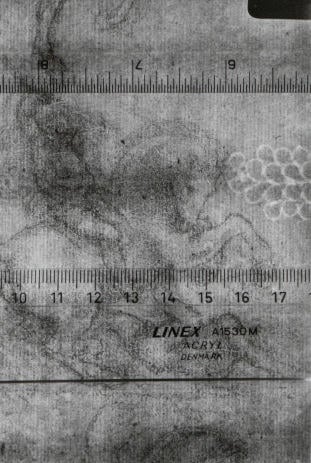-
1 of 253523 objects
Designs for an equestrian monument c.1517-18
Black chalk, pen and ink | 22.4 x 16.0 cm (sheet of paper) | RCIN 912360
-
A sheet of five studies of a horse and rider, all full length, and viewed in profile to the right. In two of the studies the horse is rearing, and in three the horse is pacing. Melzi's number 121.
Late in life Leonardo planned a third equestrian monument, following on from the abandoned monument to Francesco Sforza (see RCIN 912357, 912358) and the unexecuted Trivulzio monument (RCIN 912353, 912355, 912356). The only evidence of this putative late project is a coherent group of drawings studying a rearing or pacing horse (with or without a rider) and the anatomy of the horse. All are drawn on French paper in Leonardo’s delicate late style, in black chalk occasionally reinforced with pen and ink. In most studies the rider is shown in antique robes, and where he is in modern armour (RCIN 912343) he is not recognisable as a portrait. One study on RCIN 912360 includes the props of a tortoise and a pouring ewer, symbols of constancy and bounty, the qualities of a beneficent ruler rather than a military leader, and it is quite possible that Leonardo’s employer, the young Francis I, was the intended subject. But Leonardo seems not to have attempted large-scale or physically demanding work in his last years, and he did not put his mind to the practicalities of modelling or casting the sculpture.
In the two central studies of RCIN 912360 Leonardo returns to his first ambitions for both the Sforza and Trivulzio monuments, with the horse rearing over a fallen foe, but the designs are more compact than in RCIN 912358 or 912355, almost circular in outline and reminiscent of a coin or medal. In the larger study the raised foot of the fallen soldier supports the chest of the horse, so that its front legs are free, while the rider, in a fluttering cloak, raises a spear to strike. In the smaller study to the left, the rider, crowned with laurels, gazes resolutely forwards with no regard for the foe (perhaps a dragon) beneath his horse. The other studies show the horse in a walking pose, the rider brandishing a baton forwards or backwards. In two of the drawings a pedestal is outlined, a low rectangular structure with simple pilasters at the corners, and in the more finished study indications of a basin to receive the water flowing from the ewer.
Text adapted from Leonardo da Vinci: A life in drawing, London, 2018Provenance
Bequeathed to Francesco Melzi; from whose heirs purchased by Pompeo Leoni, c.1582-90; Thomas Howard, 14th Earl of Arundel, by 1630; probably acquired by Charles II; Royal Collection by 1690
-
Creator(s)
Acquirer(s)
-
Medium and techniques
Black chalk, pen and ink
Measurements
22.4 x 16.0 cm (sheet of paper)
Markings
watermark: Grapes, cut. Originally joined to 912342. Close to Briquet range 13034-13041: uniformly C15th and Northern, except several Piedmontese
Category
Object type(s)
Other number(s)
RL 12360Alternative title(s)
Studies for an equestrian monument


